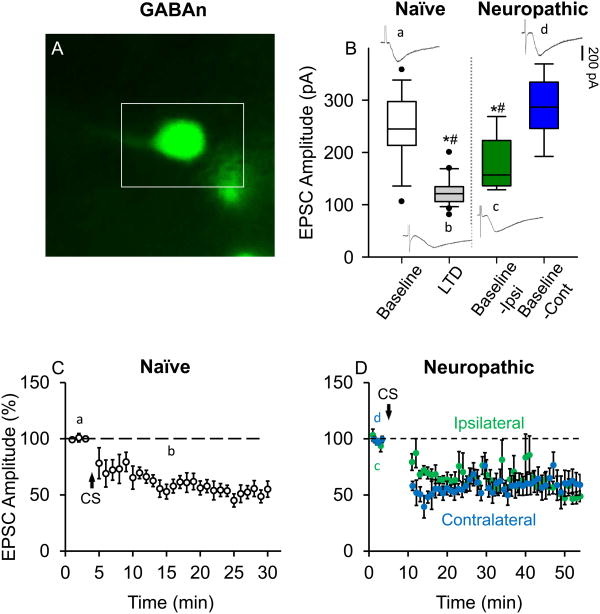Figure 4.
Long-term depression (LTD) is already established in GABAergic interneurons (GABAn) in the ipsilateral side of spinal nerve ligation (SNL). (A) GABAn GFP (green fluorescent protein)-tagged in FVB-Tg(GAD67-GFP) in the superficial laminae of the dorsal horn in a live L5 spinal cord slice. (B) Box-plot showing medians and ranges between 25th and 75th percentiles (boxes), and whiskers representing minimum and maximum values of raw EPSC amplitudes (pA) of (a) baseline (pre-CS, n=9, N=9) and (b) LTD state (15 min after CS, n=9, N=9) in naïve mice, compared to baselines in the (c) ipsilateral (Baseline-Ipsi, n=6, N=6) and (d) contralateral (Baseline-Cont, n=6, N=5) sides of SNL mice. Baseline-Ipsi was lower in amplitude than the baseline in naïve GABAn and lies in the range of LTD observed in naïve GABAn, whereas Basline-Cont was similar to the baseline in naïve GABAn under our stimulation parameters. Individual EPSC traces, designated by lowercase letters, show their corresponding areas of collection. Data were analyzed using 1-way ANOVA followed by Holm-Sidak multiple comparison tests (*, different from (a); #, different from (d); P< 0.05). (C) LTD developed in GABAn in naïve mice (n=7, N=7) and (D) both in the ipsilateral (n=6, N=6) and contralateral (n=6, N=5) sides of SNL mice after CS (2 Hz for 40 seconds, holding potential at +30 mV). Stimulation event interval was set at 20 seconds resulting in three EPSC values per minute. Individual EPSC values were normalized to the mean of baseline (before CS) EPSC values. Then each of the three normalized EPSC values (per minute) were averaged and plotted vs. time. All data were obtained from adult 4 weeks old mice.

